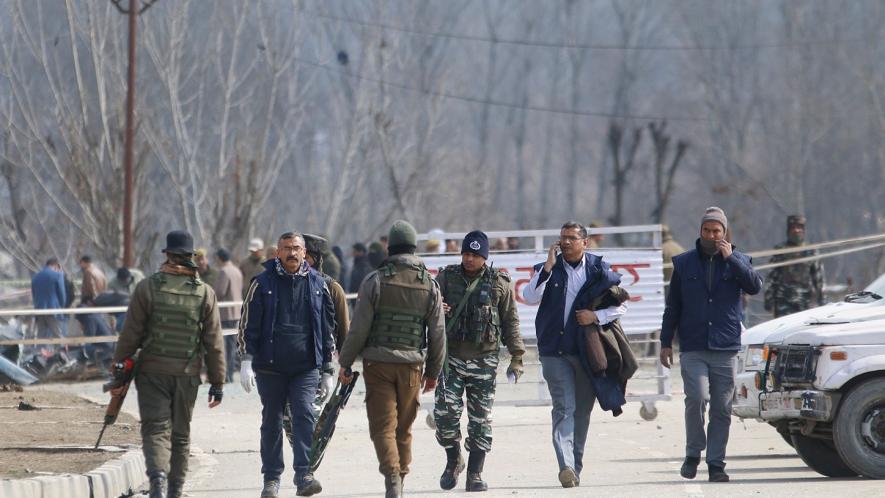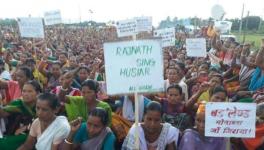Jammu and Kashmir: Making Sense of Non-Sense

Image Courtesy : Kamran Yousuf
Much of contemporary politics is choreographed; with speech to dress and content to its wrapping, that it is well-nigh difficult to know which leader is faking and who is not. In an era of “perception warfare” where truth does not matter but perception does, India’s Prime Minister can proudly claim to be a leading exponent of this ‘art’. One, who through his silence and speech, turns news into spectacle and deflects us from reality by spinning tales. India’s supine corporate owned media, follows the code of Omerta, never questions the “leader” lest their devotion for the “leader” is questioned. In such times every speech, as conspicuous silences, should be interrogated to understand their meaning.
Nine days after the Pulwama suicide bombing on February 14, in which 40 CRPF jawans lost their lives- triggering organised mob attacks on Kashmiri students, traders and employees, and two days after the Surpeme Court intervened to direct 11 states to protect Kashmiris, the Indian Prime Minister on February 23, found time to condemn attacks on Kashmiris. By then, the worst was over and the damage had been done. The PM, who knows everything, surely knew this and took the high road by insisting that India’s fight is neither with Kashmir or Kashmiris but was against “terrorism”.
Now, the attacks on Kashmiri students, traders and others that took place in full public gaze, was carried out by the cohorts of RSS, helped by the police and administration who ensured a virtually free run to such elements. Four thousand students out of 22,000 studying across India, most of them from UP, Uttarakhand, Haryana, Rajasthan and Madhya Pradesh, returned home to Kashmir. Throughout this period, when attacks were being mounted and widely aired, the PM chose to remain quiet, distant and unconcerned. Characteristically, the PM offered anodyne words but consistently desisted from chastising the rowdies, most of whom are from the RSS stable. Not a word to condemn the filth ridden & vituperative propaganda campaign mounted by them.
More strikingly, while he spoke soothing words for record, publicly he spoke that the army has been given a “free hand” to take revenge at a time and place of its choosing. Since the suicide attack was carried out in Kashmir and locals were involved, this carte blanche was meant as much for allowing them to respond to Pakistan as for Indian-administered Kashmir. Indian military forces escalated ‘Operation All Out’ against Kashmiris. Augmented deployment of troops was the first step. Thus, with 100 additional companies or 12,000 jawans of central para military forces (in addition to 400 cos or 45, 000 jawans sent last year for Panchayat polls who remain present), the surge in military force deployment was over and above the roughly 600,000 army, para military and state armed constabulary, crowding
Kashmir with military camps. All this, ostensibly to fight less than 350 militants in the state. The disproportionate size of the two forces, military and militants is an admission of the fact that these troops are meant to cow down civilians and force them to stop supporting militancy.
Also Read: Jamaat Ban May Help It in the Valley
The midnight raids and arrests of more than 550 Hurriyat and Jamaat-e-Islami (JeI) members, cancellation of doctor’s leave and asking hospitals to store medicines and food, point towards how the pitch of “Op All Out” is being raised. The latest move has been the invoking of Unlawful Activities (Prevention) Act and ban on JeI in Jammu and Kashmir, thereby, enabling that lakhs of Jamaat members, supporters, sympathisers, and their kith and kin can be persecuted as well as prosecuted. Thousands of schools run by former members of JeI too, face threat of closure, rendering at least one lakh students with a dark future. The JeI in Jammu and Kashmir is, as any serious observer of the state knows, very different from JeI of either India or Pakistan, as it has been tempered by the severe repression they have faced and has had to struggle under the most trying conditions. Their social work and other social outreach programs are common knowledge in the state. It was banned for a brief period in the 1990s, but it was lifted later and they had been free for the past 25 years. They have also officially distanced themselves from the Tehreek-i-Hurriyat of Syed Ali Shah Geelani.
Is a crackdown against Kashmiris in Kashmir what the Indian PM really meant when he spoke of “jaw breaking response” for Pulwama attack and against harbourers of “terrorists? The PM has already raised the jingoistic pitch so high that there is just no way that the thirst for revenge and teaching Pakistan a lesson would quench the bloodlust of jingoists. Although India upped the ante by launching an aerial strike (with Pakistan returning the favour by intruding into Indian air space and India suffering the loss of a fighter jet), obviously, this euphoria cannot be sustained. Because to exert sustained pressure on Pakistan means to be prepared to go to war, which neither of the two countries can afford or have the stomach for.
Also Read: BJP Moves Seamlessly into Election Mode
Jingoists, lest we forget, are a breed apart, and they worship and celebrate blood and gore of war, not having to fight it themselves, needless to add. In a recent NewsClick interview, a former Air Force combatant Rajiv Tyagi pithily observed that while people elsewhere in the world celebrate end of war, in India there are celebrations before the war has begun with Pakistan, and when the “all out operation” is being carried on in Kashmir. So, it is one thing for grainy videos/images or Bollywood films to hype up a border raid of limited consequence to become a box office hit. But in real life, it is the “dirty war” in Kashmir which is intensifying.
While jingoists in India claim that Pakistan will suffer each time there is a major terrorist attack in India, the reality is that more harm would be wrecked on the captive people in Kashmir than on Pakistan. Having whipped up an appetite for blood revenge, it is difficult to imagine the jingoists to be satisfied with a make-believe killing of 200-350 Jaish militants. Besides, the ‘surgical strike’ of 2016 was a miserable failure as it could not prevent either attacks on XVI Corps Hq at Nagrota nor the Pulwama attack. The aerial strike turned within 48 hrs from one of exultation to distress to a draw with de-escalation between India-Pakistan in tow. As against this, there is nothing to put a brake on actuality of “Op all out” in Indian administered Kashmir.
Pause and Consider
More importantly, there is a need to revisit the Pulwama suicide attack. It seems something like “Make in India” policy prevails for insurgents too, where the technology and expertise for making explosives is foreign, but the manufacturing is done in India and carried out by Indians. The Pulwama suicide bomb was made locally, the explosives presumably collected over some time to assemble and load the Maruti van with 25-30 kgs of explosives. Lt General (retd) DS Hooda ruled out the possibility of explosives coming from Pakistan. More likely is that, explosives used for road construction, especially on Jammu-Srinagar highway for digging tunnels, may have been collected. Jaish-e-Mohammaed provided the expertise. It would have required weeks, if not months of preparation. Piled up vehicles at Banihal tunnel provided the opportunity.
Five of India’s top intelligence agencies (including Intelligence Bureau and the Army’s Military Intelligence who have a ubiquitous presence in the state), none were aware of this. All leads have uncovered local participation and no credible evidence of Pakistani order to carry this out. The point is that while for the ruling establishment, Pakistan bashing may be the more lucrative deal, there should be greater focus on the local rather than external in this act. Because the question which raises itself is, why after nineteen years, since the attempted suicide attack on Badamibagh Corps Hq in 2000, did another Kashmiri choose this path? What indeed is driving the Kashmiri youth to such a state of hopelessness and desperation where defiance borne of this takes such form where they turn themselves into a weapon? Why indeed has the situation progressively declined in the past five years?
Under the disastrous governance model of Narendra Modi, militancy related incidents increased by 176% from 222 in 2014 to 614 in 2018. This is as per the written reply submitted by the Ministry of Home Affairs to Lok Sabha on February 5.Casualties suffered by security forces rose by 93%. Out of an official total of 1,315 deaths, there were 138 killings of civilians, 838 militants and 339 security forces personnel. If one adds the first two months of 2019, the number of security forces dead is 56, more than half of 2018’s 91 death. Meanwhile, the death toll of civilians generally gets downplayed as many of the civilians are described as “overground workers” of militants or stone pelters. In other words, the more important thing is what the Indian military is engaged in doing in Jammu and Kashmir.
So, is it possible that while propaganda will carry on about targetting “terrorist” camps and leaders in Pakistan, the Kashmiris in Indian administered Kashmir will remain the real targets? And while Indians were busy with the political drama over the aerial strike, conditions have turned worse for people in Kashmir with the military being given a free hand to do what they want.
An Insidious Policy
One cannot help but marvel at the insidious policy which uses the fear of a few hundred militants and uses this to crackdown on civilians and combatants alike. All the chat about Geneva Convention which one heard while Wing Commander Abhinandan was captive of Pakistan’s military, evaporate when attention is drawn to its absence in Jammu and Kashmir. It’s applicability and need is dismissed by claiming that the “Nation” can do whatever to its people, International Humanitarian Laws do not apply. For nation-states, sovereignty has come to mean that they browbeat citizens to any degree of coercion they jolly well feel because it is their sovereign right. WE ceased, it appears, to be a Republic which rests on the foundation of popular sovereignty, a long time ago.
Also Read: The Kashmir Question: A ‘Made in India’ Problem
The public mood is defiant against the military commanders because the issue needs an urgent political solution, not a bloody suppression of Kashmiris, to resolve the Kashmir Question.
It would have helped if India’s political parties from left to centre shed their coyness and spell out what they mean and how they will restore autonomy, having maintained silence on this for three decades. Until then the choice is between assimilation espoused by BJP-RSS, and the popular demand for right of self-determination, as the only peaceful political way to resolve the Kashmir dispute.
Seen in this light, the PM did not disavow the repression, but merely spoke words to show he cares for Kashmiris,when the ground reality of India and Kashmir in particular, shows that he hardly cares. The evidence in fact shows that the repression of Kashmiri Muslims under his model of governance has progressively escalated.
Get the latest reports & analysis with people's perspective on Protests, movements & deep analytical videos, discussions of the current affairs in your Telegram app. Subscribe to NewsClick's Telegram channel & get Real-Time updates on stories, as they get published on our website.
























